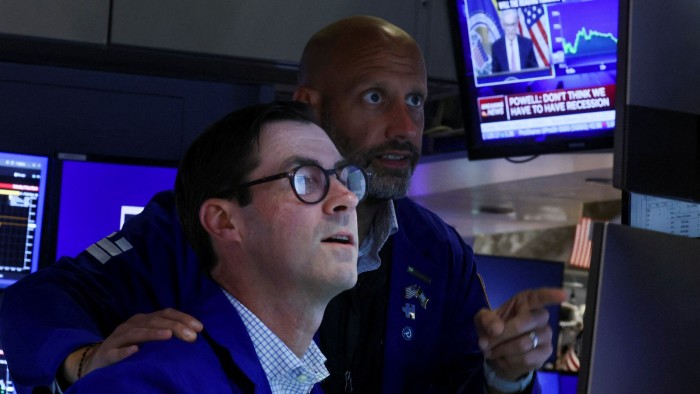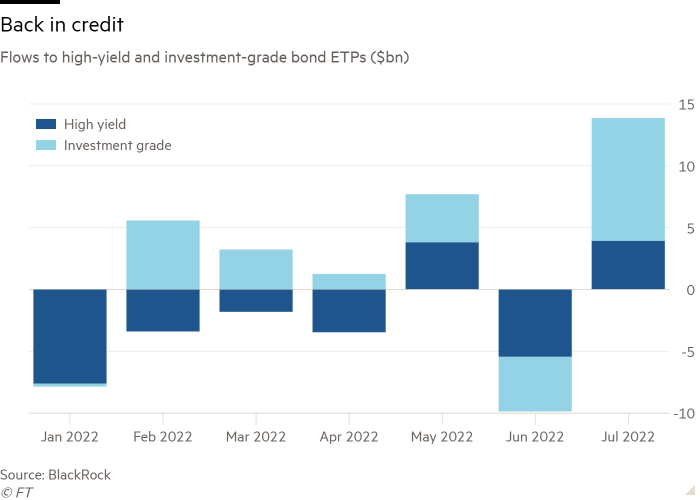Investors swarm back to corporate bond ETFs

Simply sign up to the Exchange traded funds myFT Digest -- delivered directly to your inbox.
Latest news on ETFs
Visit our ETF Hub to find out more and to explore our in-depth data and comparison tools
Money rushed back into investment grade corporate bond exchange traded funds in July with flows buoyed by “significant” buying of European-focused vehicles in a sign of improving sentiment.
Purchases of fixed income ETFs surged to $32.5bn in July from $3.2bn in June, largely due to a pick-up in credit, or corporate bond, ETF buying, which amounted to $13.8bn, more than recouping the $9.9bn lost in outflows in June, according to monthly global flows data from BlackRock.
Investment grade credit vehicles accounted for the lion’s share of inflows, taking in $9.9bn in July. European-focused investment grade ETFs stood out, with the $2.2bn in net new cash they attracted in July the highest monthly inflow since April 2020, when markets started to recover from the initial pandemic shock.
“The first half of the year saw European corporate credit become increasingly attractive versus rates [government bonds] and equities,” said MJ Lytle, chief executive of Tabula Investment Management, a bond ETF specialist.

He said yields had increased over the first half from less than 1 per cent to more than 3.5 per cent for European investment grade bonds and from around 3 per cent to almost 8 per cent for European high-yield paper. When yields on bonds go up, prices go down.
“European high yield has been trading at levels rarely seen since the global financial crisis, with the peak in July being higher than 93 per cent of all readings since the end of 2009,” said Lytle. “July’s inflows into European corporate credit ETFs suggest a tipping point in terms of investor sentiment as investors seek to capitalise on these higher yields.”
Karim Chedid, head of investment strategy for BlackRock’s iShares ETF arm in the Emea region, also noted the pricing appeal. “Investors could be taking a view on cross-sector allocation because credit looks cheaper than equities,” Chedid said. But he added: “Credit is not cheap outright, it’s just cheaper than it used to be, so it’s a sign that investors are seeing value.”
However, BlackRock noted that the reversal was a continuation of the “inconsistent flows” that have been a trend this year.
Kenneth Lamont, senior fund analyst for passive strategies at Morningstar, agreed, saying the fundamentals had not changed much.
“Looking at flows for euro-denominated investment grade ETFs domiciled in Europe, I can see there have been net inflows one month and outflows the next throughout this year.”
However, Todd Rosenbluth, head of research at VettaFi, said investors had been cheered by indications that the US Federal Reserve was determined to tackle inflation.
The Fed raised its benchmark policy rate by 0.75 percentage points for the second month in a row on July 27.
“As investors gained more confidence, the US Federal Reserve had a better handle on mitigating the impact of inflation [and] investors globally were willing to take on credit risk. Investors rotated from ultra short [duration] bond ETFs to those with higher yields,” Rosenbluth said.
He said ultra-short duration ETFs, such as the SPDR Bloomberg 1-3 Month T-Bill ETF (BIL) and the iShares 1-3 Year Treasury Bond ETF (SHY), which own Treasuries with very low interest rate risk, had seen heavy outflows in July.

Click here to visit the ETF Hub
Comments